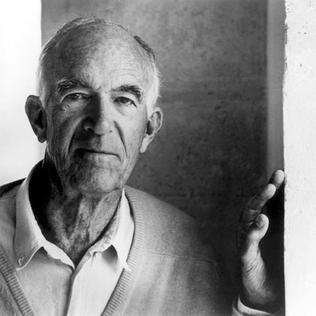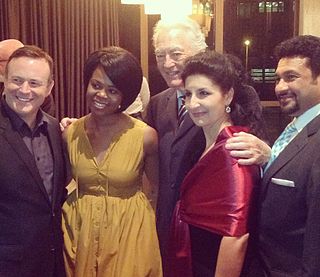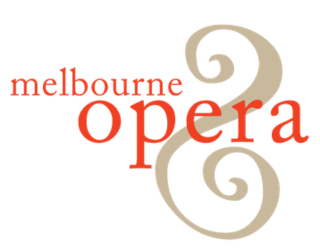
The Sydney Opera House is a multi-venue performing arts centre in Sydney, New South Wales, Australia. Located on the foreshore of Sydney Harbour, it is widely regarded as one of the world's most famous and distinctive buildings and a masterpiece of 20th-century architecture.

Jørn Oberg Utzon was a Danish architect. In 1957, he won an international design competition for his design of the Sydney Opera House in Australia. Utzon's revised design, which he completed in 1961, was the basis for the landmark, although it was not completed until 1973.

Opera Australia is the principal opera company in Australia. Based in Sydney, New South Wales, its performance season at the Sydney Opera House accompanied by the Opera Australia Orchestra runs for approximately eight months of the year, with the remainder of its time spent at the Arts Centre Melbourne, where it is accompanied by Orchestra Victoria. In 2004, the company gave 226 performances in its subscription seasons in Sydney and Melbourne, Victoria, attended by more than 294,000 people.

The Sydney Conservatorium of Music (SCM) — formerly the New South Wales State Conservatorium of Music, and known by the moniker "The Con" — is the music school of the University of Sydney. It is one of the oldest and most prestigious music schools in Australia, founded in 1915 by Belgian conductor and violinist Henri Verbrugghen.

The Sydney Symphony Orchestra (SSO) is an Australian symphony orchestra based in Sydney. With roots going back to 1908, the orchestra was made a permanent professional orchestra on the formation of the Australian Broadcasting Commission in 1932. The orchestra has performed at the Sydney Opera House as its home concert hall, since the venue's opening in 1973. Simone Young is the orchestra's chief conductor and the first female conductor in the post.

John Joseph Cahill, also known as Joe Cahill or J. J. Cahill, was a long-serving New South Wales politician, railway worker, trade unionist and Labor Party Premier of New South Wales from 1952 to his death in 1959. Born the son of Irish migrants in Redfern, Cahill worked for the New South Wales Government Railways from the age of 16 before joining the Australian Labor Party. Being a prominent unionist organiser, including being dismissed for his role in the 1917 general strike, Cahill was elected to the Parliament of New South Wales for St George in 1925.

Richard Alan Bonynge is an Australian conductor and pianist. He is the widower of Australian dramatic coloratura soprano Dame Joan Sutherland. Bonynge conducted virtually all of Sutherland's operatic performances from 1962 until her retirement in 1990.

Away is a play written by Australian playwright Michael Gow. First performed by the Griffin Theatre Company in 1986, it tells the story of three internally conflicted families holidaying on the coast for Christmas, 1968.
Neil Geoffrey Armfield is an Australian director of theatre, film and opera.

Pinchgut Opera is a chamber opera company in Sydney, Australia, presenting opera from the 17th and 18th centuries performed on period instruments. Founded in 2002, Pinchgut stages two operas each year in Sydney's City Recital Hall. It also performs concerts in both Sydney and Melbourne.

Simone Margaret Young AM is an Australian conductor and academic teacher. She is currently chief conductor of the Sydney Symphony Orchestra.

Richard James Gill was an Australian conductor of choral, orchestral and operatic works. He was known as a music educator and for his advocacy for music education of children.
The Zephyr Quartet is a string quartet based in Adelaide, South Australia. Founded in 1999, they have been recognised with awards and have collaborated with international musicians.

Melbourne Opera was founded in 2002 as a charitable not-for-profit company dedicated to producing opera and associated art forms in Melbourne, Australia. With philanthropic assistance it has also toured to outer-suburban and regional Victorian theatres, as well as to Canberra and Hobart interstate. Despite receiving no government funding since its foundation, the company mounts between three and five main stage productions each year. Its principal rehearsal and performance home is the Athenaeum Theatre.
Donald Robert Shanks AO OBE was an Australian bass-baritone singer who sang over 65 principal roles with Opera Australia and other companies in Australia and overseas. Moffatt Oxenbould said that he had "an immensely important place in the history of opera in this country".
Emma Matthews is an English-born Australian lyric coloratura soprano, noted for operatic roles, but also popular on the concert stage. A Principal Artist with Opera Australia, Matthews has received more Helpmann Awards than any other individual artist, nine Green Room Awards, the Mo Award and the Remy Martin Australian Opera Award.
The Australian World Orchestra (AWO) is a symphony orchestra based in Australia.
Kim David Carpenter is an Australian visual artist, theatre director, designer and devisor. For thirty years he was artistic director of his company, Kim Carpenter's Theatre of Image.
This article is for major events and other topics related to classical music in 2021.

Peter Brian Hall was an Australian architect active in Sydney and elsewhere from the 1950s to the early 1990s. Schooled in the tenets of modernism his practice was also informed by a strong sense of the importance of function and context in design. During his early years Hall was the recipient of numerous education scholarships and bursaries, most notably a traineeship and then employment with the office of the New South Wales Government Architect, a source of highly creative architecture during the 1960s. However, Hall is best known for completing the Sydney Opera House after the resignation of its original architect, Jørn Utzon, in February 1966. At the age of 34, he was invited by the Government Architect to act as design architect in the newly formed consortium Hall Todd & Littlemore to resolve the issues which had led to Utzon's resignation, principally the design of all the interiors and the enclosing glass walls of the unfinished building. The Opera House opened in October 1973 and despite its subsequent success as Sydney's most popular performance venue, understanding of the work of Hall and his team has been coloured by the controversial circumstances of their appointment. For Hall, both personally and professionally, Utzon's legacy was a poisoned chalice – an unprecedented challenge to complete the building to a standard commensurate with its sublime exterior, but one that brought little recognition during his lifetime.













